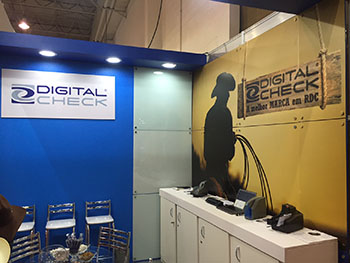 Last month, Digital Check attended CIAB Febraban, Brazil’s largest banking and payments event, in Sao Paulo. Amid all the Olympic, political and economic hype going on there now, we found a surprisingly well-attended and upbeat conference, with the industry more focused on some big opportunities coming up on the horizon than on the dreary mire being portrayed in the present.One of these opportunities is remote deposit capture, which has been in the works for a few years now as the country modernizes its check clearing system. In 2011-12, banks there began clearing scanned images of checks – in itself a tremendous boon to the industry, given the extreme difficulty and expense of transporting paper checks across long distances, in a country that includes some of the most inaccessible territory on earth. More recently, Brazilian banks have started to roll out remote deposit capture; last year, Banese a small state-run bank in the northwestern part of the country, became the first to offer RDC for businesses.
Last month, Digital Check attended CIAB Febraban, Brazil’s largest banking and payments event, in Sao Paulo. Amid all the Olympic, political and economic hype going on there now, we found a surprisingly well-attended and upbeat conference, with the industry more focused on some big opportunities coming up on the horizon than on the dreary mire being portrayed in the present.One of these opportunities is remote deposit capture, which has been in the works for a few years now as the country modernizes its check clearing system. In 2011-12, banks there began clearing scanned images of checks – in itself a tremendous boon to the industry, given the extreme difficulty and expense of transporting paper checks across long distances, in a country that includes some of the most inaccessible territory on earth. More recently, Brazilian banks have started to roll out remote deposit capture; last year, Banese a small state-run bank in the northwestern part of the country, became the first to offer RDC for businesses.
This year, check capture technology has moved forward incrementally, with Brazil’s largest bank, Bradesco, joining Banese in the desktop RDC space, and most of the major institutions either rolling out or implementing mobile RDC for consumers.
As our representatives at the show explained, there is a lot of expectation that remote deposit, and possibly mobile RDC, will serve small businesses – but right now most of the action is around mobile RDC as a marketing tool to attract individual consumers. The volume of checks actually deposited with mobile RDC is still very low, but because it’s relatively easy to add to existing mobile apps, most banks there have decided to go the mobile route first and then backfill with higher-volume desktop applications later. As one attendee told us, “If you don’t have it, it’s embarrassing.”
While it might seem odd that there’s so much focus on checks in Brazil, the country is responsible for the second highest volume of written checks in the world, behind only the United States. A lot of this has to do with their use of post-dated checks as a sort of informal credit system: Rather than pay for a purchase up front and make monthly payments on a balance, itis common practice to hand a merchant a stack of checks dated monthly until the full amount is paid off. In this respect, the check has developed into its own unique payment method with a special niche that it fills nicely.
Exactly halfway around the world in Manila, the Banco Sentral ng Pilipinas announced that the Philippines would transition to electronic check clearing by January 6, 2017. That’s welcome news in a country where, according to a study cited by the central bank, only 1% of retail payments were handled electronically as of 2014.
The Philippines’ decision to modernize, rather than eliminate, its check clearing system, presents the most recent point of comparison to Digital Check’s own research on the potential ending date of the paper check as a payment method. The Philippines process about 200 million checks per year – about a tenth as many per capita as Brazil, with which it shares many of the same geographic challenges of physical clearing. This is also roughly one-twelfth as many checks per capita as the British, who came the closest to phasing out checks (without actually doing so) out of the countries we studied. If this trend repeats itself elsewhere in coming months, it may signal that the “floor” at which checks cease to exist as a relevant payment method may be notably lower than previously thought.





